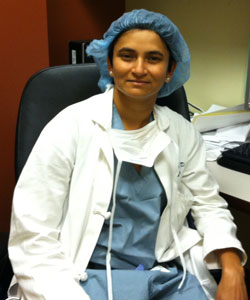The Next Generation

Sudha Jayaraman, MD,
MSc |
Sudha Jayaraman, MD,
MSc, an acute care surgery fellow in the BWH Division of Trauma, Burns and
Surgical Critical Care, recently spent three weeks as a visiting surgeon in the
trauma unit at Charlotte Maxeke Johannesberg Academic Hospital in Johannesberg,
South Africa. She was supported by the Partners Centers of Expertise Global Health
travel grant. Her interests are in trauma and emergency surgery, health
disparities and improving access to health care for underserved populations in
the U.S. and around the world. She is currently working on her division's
collaboration in Rwanda at the National University of Rwanda to improve access
to trauma and emergency care.
She wrote this post
during her time in Johannesberg, or "Joberg."

Trauma and Critical
Care at a South African Hospital: Disparities, Conundrums and Contradictions
The most striking aspect of my visit to Joberg was the recognition of
disparities on many different levels. I didn't realize that South Africa has
among the highest Gini coefficients of all the countries around the world per
the World Bank, but I certainly noticed it very quickly during my trip. (The
Gini coefficient is a measure of income inequality with high values indicating
greater disparities in income distribution.)
Obviously, there are disparities between the U.S. and S.A. in the quality of
health care which is largely related to disparities in health care funding
between the two countries; 18 percent of GDP in the U.S. is spent on health
care, versus 9 percent in S.A., per the World Bank.
However, disparities in income and class were quite stark. There is a clear
predominance of black South Africans in the public hospitals, for example,
compared to the wealthier white and Indian populations in the private
facilities. This difference was noticeable in general society as well. Joberg
is known for its fancy malls with all the most famous high-end European and
American clothing and accessory shops. Visit one of them and disproportional
distribution of black waitstaff and a largely white clientele is quite obvious.
Capetown, which I visited for two days, had the same skew in the staff and
clientele in the posh restaurants lining the coast.
There were also striking disparities in care between hospitals in Joberg. I was
struck by the differences between the public and private hospitals in the city.
While the same surgical faculty worked at both the public hospitals (Joberg Gen
and Baragwanath Hospital) and the private hospitals (Milpark and Donald
Gordon), I could not help but notice the differences in resources between these
facilities. The 30 ICU beds at Milpark that are solely allocated to trauma
patients compared to the 4 ICU beds at Bara which meant that a ventilated
patient at Bara might end up on the general surgical ward along with 60-plus
other patients.
The disparate burden of trauma, especially on black versus white and Indian
children, was painful for me to see, especially as a mother of an active
three-year-old. Every day, I passed kids of all ages as I walked through two of
the most elite private prep schools in the country on my way in to the hospital
- St. John's (boys) and Rodean (girls). The schools were largely filled with
white and Indian children with a significant but small minority of black
children. The casualty ward at Joberg Gen told the opposite story every night.
The first Friday and Saturday nights I spent on call, I saw five young black
South Africans die. They were between the ages of 15 and 30.
At Bara, on one of the few nights I visited, I saw four black children, from
different families, present with large burns. They were all under the age of
three.
It is winter in Joberg, and the evenings/nights can get quite cold (30s
Fahrenheit). Poorer families often use open air fires for warmth or for cooking
and children can easily become casualties.
Ninety percent of deaths from injury happen in low and middle income countries
while the majority of research and funding for trauma are focused in high
income countries. My visit to Joberg Gen only made me more acutely aware of
that disparity and made me more convinced that I should be part of efforts to
change that inequality.